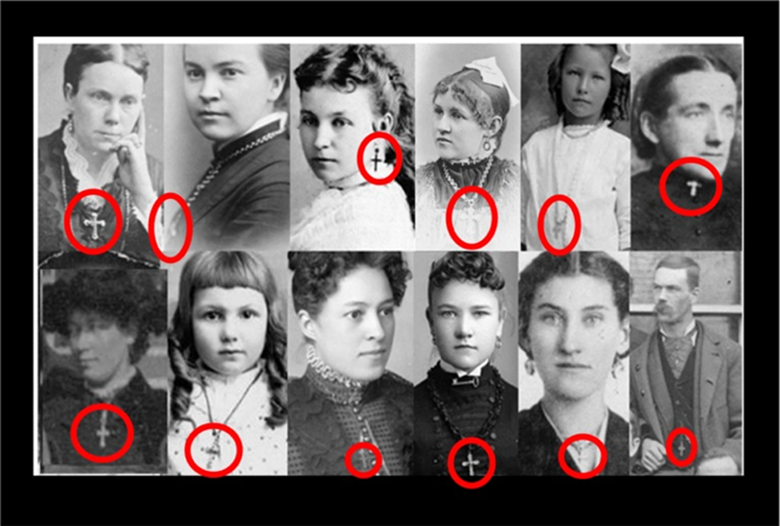If you’d like to receive weekly emails with my new Come Follow Me Videos and also get a free chapter from Considering the Cross: How Calvary Connects Us with Christ, sign up here.
One of the questions I’m most frequently asked is why don’t members of the Church of Jesus Christ of Latter-day Saints use the cross as a symbol?
There is A LOT of misinformation about this topic, and if you’re a member of The Church of Jesus Christ of Latter-day Saints, it’s likely that you’ve been taught things that are cultural rather than doctrinal.
If you want a full explanation via video, including all the nuances and details, watch this Ensign College Devotional, “The Cross: A Bridge, Not A Barrier. You can also listen to an audio version or read the written transcript.
If you’re interested in a shorter video, I recommend this one by by Saints Unscripted.
If you’d rather read about the answer to this question and learn more about these pictures…keep going!



“Can you guys wear or display crosses?”
The standard response many members give is to paraphrase a statement made by President Gordon B. Hinckley in 1975. He explained the Church’s institutional practice of not having crosses in our buildings by relating an experience he had giving a tour of a temple. A Protestant minister pointed out the absence of the cross in the temple and, noting that it was the symbol of Christianity, asked how Latter-day Saints could claim to be Christians without the cross. President Hinckley responded, “For us, the cross is the symbol of the dying Christ, while our message is a declaration of the living Christ. . . . The lives of our people must become…the symbol of our worship.”
The importance of worshipping the living Christ cannot be overstated. At the same time, if we focus on the cross exclusively as a representation of a dying Christ, we ignore the fact that symbols are multifaceted: they permit, even invite, layers of meaning. For example, imagine your colleague just gave an outstanding presentation and asks for your response. If you give her a thumbs up signal, what message are you conveying?
Most westerners will identify this as a signal that means “great job”; however, if this event transpires in a middle eastern country where a “thumbs up” has a negative connotation, your message would be perceived quite differently.
Similarly, the symbol of the cross means different things to different people. Some may view the cross as an image of death to be avoided. Others see it as a symbol of suffering that comforts us in pain or a representation of Christ’s triumph over death. Indeed, were a Church member to say to a fellow Christian, “Why do you focus on Christ’s death by wearing a cross?” the result would likely be hurt feelings. Eric Huntsman, professor of ancient scripture at Brigham Young University, recounted the following story:
A. . . Presbyterian friend corrected me when I told her that we preferred to worship a living rather than a dead Christ; she responded that she did too. The cross reminded Protestants that Jesus died for their sins, but it was empty because He was risen and was no longer there on it. I was chastened by her response, realizing that just as we do not appreciate others mischaracterizing our beliefs, neither should we presume to understand or misrepresent the beliefs and practices of others
Let’s consider some additional contextual background about the Church and the cross. When Joseph Smith organized the Church in 1830, Baptists, Methodists, and most Protestant churches didn’t use crosses in their architecture and Catholic churches were relatively scarce. In other words, Joseph Smith didn’t consciously decide the cross was bad, it was just not part of his cultural context.
Some early Church leaders metaphorically spoke of the cross as a symbol of Jesus Christ. For example, Elders Heber C. Kimball and Orson Hyde, reporting on their mission to England, wrote to Joseph Smith, “We have fought in the name of the Lord Jesus, and under the shadow of the cross we have conquered.”
On another occasion, Orson Hyde described his plea to the Lord: “Let the enemies of the cross be confounded and put to shame before the sublimity and power of [my] arguments. Let [me] raise the standard of the cross in every land and nation where [I] shall go; and let the simple and broken hearted flock unto it and rejoice beneath its heavenly banner.”
Crosses became a common feature in American Christian churches between 1840 and 1870—a time period when the Church was largely isolated in Utah. During this time however, it was not uncommon for people to wear cross jewelry, as illustrated in the below photographs of Latter-day Saints.

Some church buildings during the late 1800s and early 1900s had crosses on them.

Even some modern churches today have crosses (this one is in Tennessee).

The 1852 edition of the Doctrine and Covenants had crosses printed on it.

In 1916, the president of the Church approved placing a large cross on Ensign Peak. Although this proposal was later shelved, the fact that it was approved by the President Joseph F. Smith indicates that he viewed the symbol of the cross in a positive light. During this same time period, some Latter-day Saint Boy Scouts, accompanied by General Authorities (including future Church President George Albert Smith), erected a cross as a monument in Emigration Canyon.
Crosses were displayed at the funerals of church leaders, including church President John Taylor and Relief Society President Eliza R. Snow. In addition, Elder B.H. Roberts of the Seventy has a cross on his gravestone.

Given all of this background, why do many members have a negative view of the cross as a symbol?
In 1957, President David O. McKay wrote in his journal entry about a conversation he had with the Bishop Bishop about whether it was okay for LDS girls to buy cross necklaces. He wrote, “I told Bishop Wirthlin that this is purely Catholic and Latter-day Saint girls should not purchase and wear them. I stated further that this was a Catholic form of worship. They use images, crosses, etc. Our worship should be in our hearts.”
Given that the cross was by this time a generally accepted symbol of Christianity, it is not clear what shaped President McKay’s view that wearing a cross “was a Catholic form of worship.”
There is no indication that President McKay’s private journal entry regarding the wearing of crosses was widely known among Church members; however, between 1950 and 1970 there were two published statements from church leaders suggesting that for Church members to wear or display a cross would be in poor taste—although it’s important to note that no Church leaders have publicly forbidden wearing or displaying crosses. We certainly should follow the counsel of living prophets, seers, and revelators. At the same time, we know that specific practices and applications can shift over time.
For example, there are at least sixteen public statements from Church leaders in previous decades that discourage drinking caffeinated soda. The statements cautioning against caffeinated soft drinks are more severe and vastly outnumber the statements discouraging wearing or displaying crosses. Caffeinated soda no longer carries a stigma in Latter-day Saint culture—should displaying or wearing a cross?
Let me be clear—I’m not suggesting that Latter-day Saints need to wear or display crosses. I am suggesting there shouldn’t be a stigma if people do wear or display crosses. The meaning of the visual symbol of the cross is more cultural than doctrinal and we shouldn’t make an issue of it when people use the symbol of the cross to remind themselves of Jesus Christ. Nearly all Christians believe Christ died for our sins and for many, the cross represents their faith in Jesus Christ. If Latter-day Saints focus on the cross exclusively as a representation of a dying Christ, it can lead to inappropriate behaviors. Consider my friend’s experience—while I’m not suggesting we all need to do exactly what he did, I admire his willingness to defend others who were being picked on. He recounts,
While I was serving in a Bishopric, a family got baptized. The primary age girl came to church following her baptism wearing a cross necklace. Her grandma, who was not yet baptized, also came to church wearing a cross necklace.
During a visit with this family, they shared with me that the primary age girl was told by one of her classmates, “You shouldn’t wear that cross. It’s bad.” The Grandma was also told by an adult church member, “You shouldn’t wear that necklace at our church.”
I asked the girl and her Grandma to tell me why they wore the cross. They shared with me their gratitude for the sacrifice Jesus made for them. I told them, “Please continue to wear your necklaces. I will wear the symbol of the cross on Sunday as well.” I purchased a pair of cross cufflinks and wore them each Sunday to church.
On occasion I was asked by members of the ward about my cross cufflinks. One asked me, “Why would you wear a symbol of Christ’s death?”
I answered, “The cross is not a symbol of death. It is a symbol of life. It is a symbol of the Savior’s triumph over death.”
The member replied, “I have never thought of it like that.”
I’m grateful my friend was there to ease the pain of some people who could easily have been offended at the way they were treated. I wonder how many visitors or recent converts have left because of unnecessary comments made about a cross they displayed or wore.
The apostle Paul wrote that he gloried “in the cross,” and said, “The preaching of the cross . . . is the power of God” (Galatians 6:14, 1 Corinthians 1:18). Jesus Christ said, “My father sent me that I might be lifted up upon the cross” (3 Nephi 27:14).
I recently noticed a pattern in how the Savior introduces himself. When he visited the Nephites he said, “I…have been slain for the sins of the world” (3 Nephi 11:14). When he appeared to Joseph Smith in the First Vision he said, “I was crucified for the world.” He introduces himself similarly on multiple occasions in the Doctrine and Covenants, with statements like, “I am Jesus Christ…who was crucified for the sins of the world” (Doctrine and Covenants 35:2). He said that at his Second Coming he will declare, “I am Jesus that was crucified” (Doctrine and Covenants 45:52).
Whatever we might think of the symbol of the cross, remember, the Savior’s Crucifixion is important to him—throughout scripture it is a key way in which he identifies himself. Today, some may choose to wear or display images of the cross or Crucifixion to remind themselves or teach their children of Christ’s love, shown through His atoning sacrifice. Others prefer to avoid images related to Christ’s death and instead focus on different symbols to remind them of the Savior’s Atonement. Either way, instead of judging the actions of others, we can all treasure the doctrine that Jesus Christ was, in his own words, “crucified for the sins of the world” (D&C 53:2).
This post has only scratched the surface. To learn more about the meanings of the cross as a symbol, including much more context than what is shared in this post, please see chapter 1 of my book Considering the Cross: How Calvary Connects Us with Christ.
If you’d like to receive weekly emails with my new Come Follow Me Videos and also get a free chapter from Considering the Cross: How Calvary Connects Us with Christ, sign up here.





